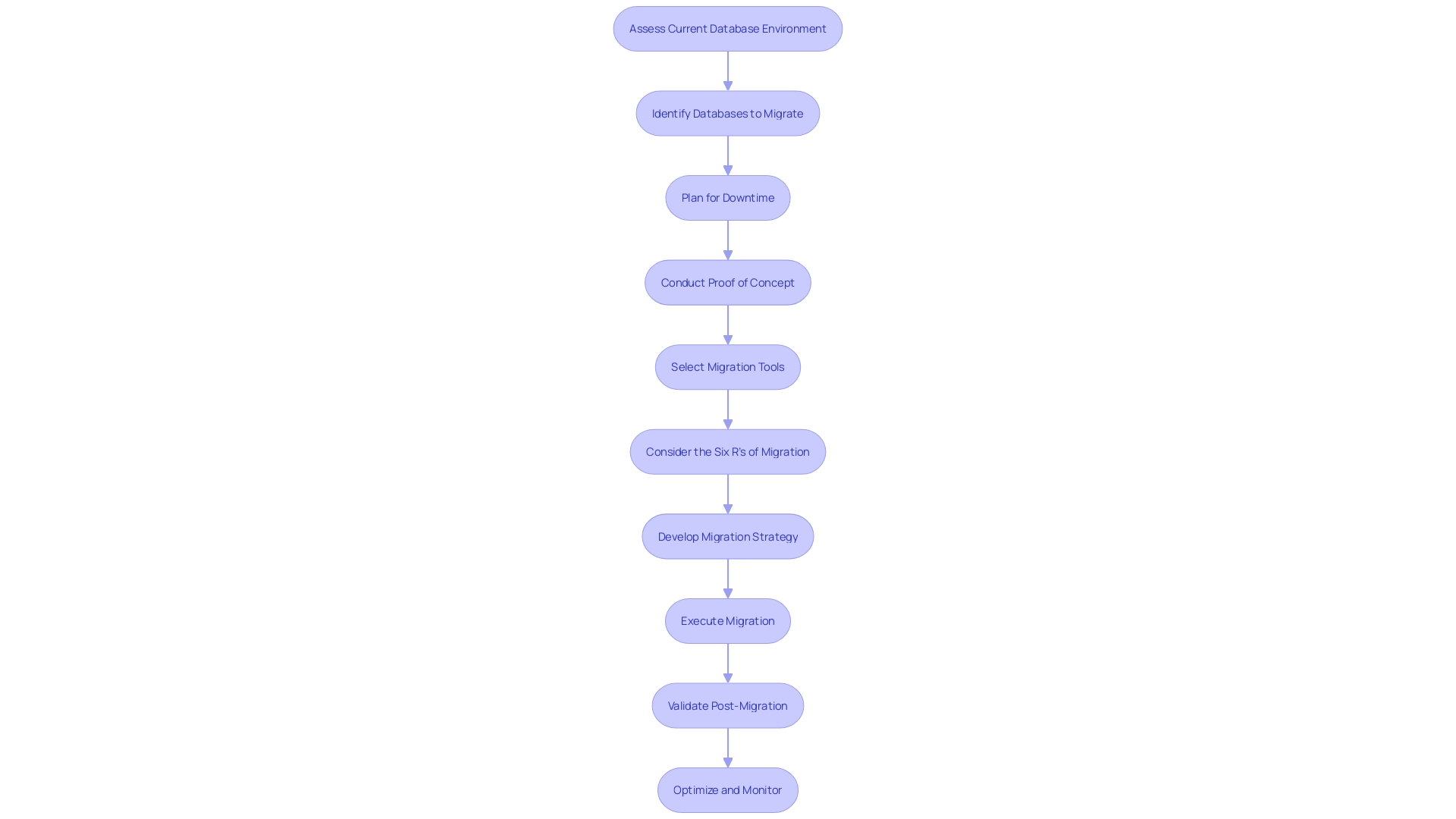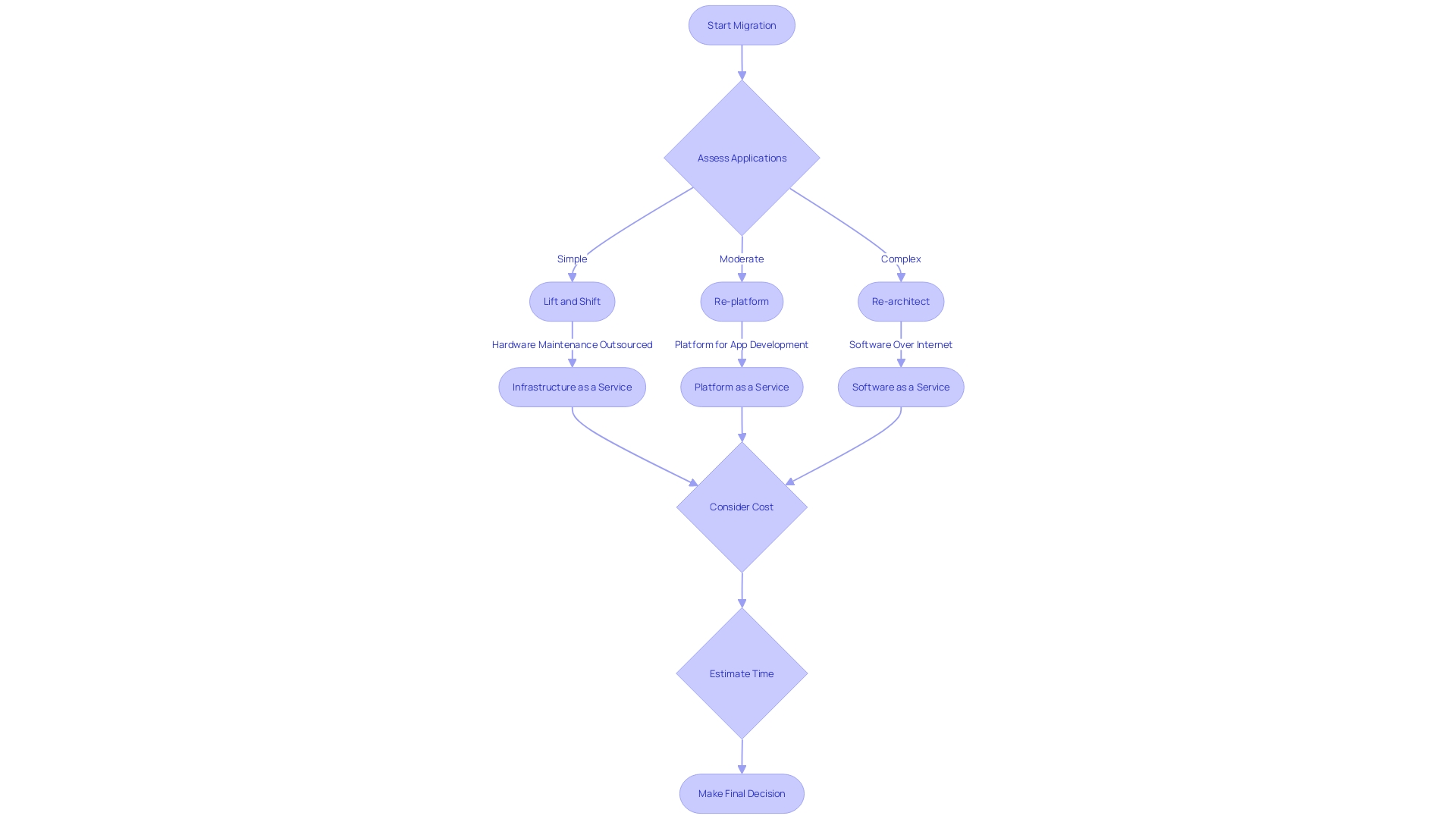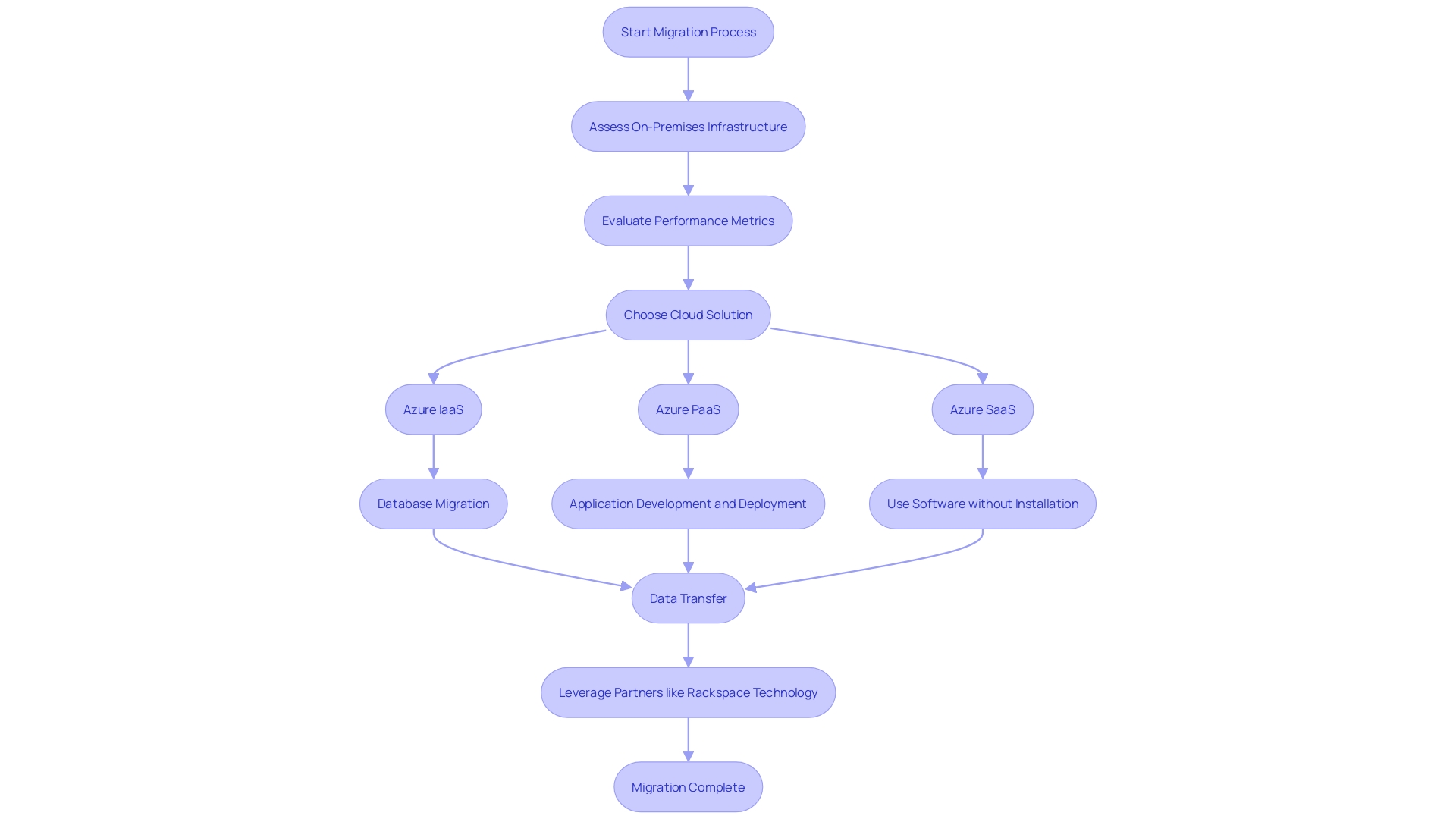Introduction
Azure Cloud Solutions offer a transformative platform for businesses and enterprises looking to scale their operations and enhance flexibility while reducing infrastructure costs. With a comprehensive suite of services designed for easy provisioning and management, Azure provides organizations with the tools they need to reimagine technology usage and foster digitization. Knorr-Bremse, a leading manufacturer of safety-critical components, leveraged Azure to become a data-driven company and eliminate data center costs.
Azure's worldwide network of data centers delivers exceptional availability, facilitating robust disaster recovery solutions. Additionally, migrating to Azure arms organizations with advanced security features and compliance certifications, crucial aspects in the era of AI and machine learning. By integrating Azure's cloud solutions, organizations gain agility, robust security, and access to innovative tools necessary for future success.
Azure is not just a solution but a strategic partner in IT modernization, offering a new discount on Azure VMware Solution to support businesses in their cloud endeavors.
Benefits of Azure Migration
Azure Cloud Solutions provide a transformative platform for businesses and enterprises looking to scale their operations and enhance flexibility while reducing infrastructure costs. The comprehensive suite of services, such as virtual machines, storage options, and expansive networking capabilities, are designed for easy provisioning and management. A notable case is Knorr-Bremse, a leading manufacturer of safety-critical components for rail and commercial vehicles, which leveraged Azure to reimagine technology usage and foster digitization, aiming to become a data-driven company and eliminate data center costs.
Azure's worldwide network of data centers delivers exceptional availability, facilitating robust disaster recovery solutions. A poignant example is IFCO, with a small IT department, which collaborated with Rackspace Technology to tap into their extensive cloud migration experience. This partnership provided IFCO with invaluable insights and alternative strategies, emphasizing customer-centric solutions and leveraging Azure's capabilities to meet their needs.
Moreover, migrating to Azure arms organizations with advanced security features and compliance certifications to protect sensitive data, a vital aspect as we step into the era of AI and machine learning. The platform's security, safety, reliability, and compliance offerings are in line with the top demands of industry leaders, as echoed by the insights shared at Microsoft Build. These features are integral to the platform, enabling developers to create transformative applications with peace of mind.
The integration of Azure's cloud solutions aligns with the strategic visions of enterprises seeking agility to swiftly respond to business needs, robust security and compliance postures, and access to innovative tools necessary for future success. Azure is not just a solution but a strategic partner in the journey of IT modernization and long-term platform strategy, offering a new 20% discount on Azure VMware Solution to support businesses in their cloud endeavors.
Preparation for Azure Migration
Preparing for an Azure migration requires a meticulous approach, beginning with a thorough assessment of the current database environment. This means identifying the databases to migrate and determining the necessary resources and configurations for Azure SQL. It's important to plan for any expected downtime and take steps to preserve data integrity during the transfer.
Before fully committing to a migration, conducting a proof of concept (PoC) is advisable. By migrating a non-essential database or a subset of data, organizations can evaluate the migration process, identify potential issues, and verify that all systems operate as expected. Once the PoC yields satisfactory results, the migration to Azure can proceed in earnest.
As for the migration itself, there are several strategies and tools available, tailored to specific needs and database types. Among these are the Azure Data Migration Service (DMS), Azure Database Migration Service, and Azure Migrate.
It is also crucial to consider the six R's, which are common strategies for cloud service migration. These include Rehosting, Refactoring, Rearchitecting, Rebuilding, Replatforming, and Retiring. Each strategy comes with distinct advantages and considerations, allowing for a customized approach to meet particular requirements, constraints, and goals.
Throughout this process, remember that a cloud migration is not merely a technical endeavor but a strategic one that encompasses technical, operational, financial, and security aspects. A well-devised strategy will minimize business disruption, control costs, and mitigate risks effectively.
To illustrate, companies like IFCO have leveraged partners like Rackspace to tap into their extensive experience with cloud migrations, ensuring a smooth transition. Similarly, industry innovator Knorr-Bremse seized the moment to move to the cloud, aligning with their strategic goal of data-driven growth and eliminating datacenter costs.
In summary, a successful Azure migration hinges on careful planning, understanding the interdependencies of your applications, and selecting the right migration strategy that aligns with your business objectives.

Choosing the Right Migration Strategy
Migrating to Azure involves various strategies tailored to meet specific organizational needs, factoring in cost, complexity, and time constraints. The 'lift and shift' approach transplants applications to Azure with minimal alteration, a pragmatic choice for companies seeking a quick migration without reengineering their systems. Re-platforming, on the other hand, makes slight modifications to take advantage of Azure's native features, thereby enhancing performance. For a more profound transformation, rearchitecting is the path to fully optimize applications within the Azure ecosystem, a strategy that echoes Knorr-Bremse's ethos in their cloud migration journey, as they sought to evolve into a data-driven entity and eliminate datacenter costs. As underlined by Thomas Auer of Knorr-Bremse, seizing the moment to transition to the cloud aligns with strategic growth and technology modernization.
Similarly, IFCO Systems' cloud adoption narrative showcases the importance of a trusted partnership, as articulated by Axel Bellermann, with a compact IT team seeking expert guidance from Rackspace in navigating the complexities of cloud migration. The emphasis on customer-centric solutions and leveraging Rackspace's proficiency underscored a bespoke migration path for IFCO, mirroring the diverse approaches available for Azure transitions.
Industry leaders recognize the urgency of cloud migration, with Oracle's forward-looking statements about Oracle Database@Azure highlighting the need for best-in-class capabilities to support such transitions. The narrative is clear: cloud migration is not a one-size-fits-all endeavor. It requires meticulous planning and execution, considering the unique technical, operational, financial, and security dimensions of each organization. The blueprint for a successful Azure migration lies in understanding the intricacies of each strategy and aligning them with the organization's overarching goals and technical landscape.

Tools and Services for Azure Migration
Azure Cloud Solutions offer a cohesive ecosystem to facilitate the migration, integration, and optimization of workloads for businesses transitioning to the cloud. Azure Migrate serves as the central hub for this process, delivering vital tools for assessing on-premises infrastructure and guiding the migration journey. It provides in-depth analysis of existing systems, highlighting dependencies while evaluating performance metrics and cost implications.
Additionally, Azure Site Recovery ensures business continuity with its automated replication and failover capabilities for virtual machines, effectively minimizing disruptions during transition periods. For database migrations, Azure Database Migration Service streamlines the process of moving on-premises databases to the cloud, offering a structured pathway to Azure. When dealing with substantial data volumes, Azure Data Box becomes an instrumental solution, enabling the secure and efficient offline transfer of data to Azure data centers.
Renowned companies such as IFCO have leveraged these Azure services in conjunction with partners like Rackspace Technology to navigate the cloud migration landscape successfully. IFCO's small IT department, new to cloud technologies, benefitted from Rackspace's extensive experience, gaining alternative approaches and insights during the migration process.
For Knorr-Bremse, an industry leader with a significant global footprint, the pivot to Azure Cloud Solutions marked a strategic decision to eliminate data center costs and bolster digitization efforts. As part of their cloud-first strategy, they aim to foster innovation and maintain a competitive edge by developing new products through cloud technologies.
The transformation to Azure is not limited to traditional business applications but extends to empowering intelligent app development. The synergy between Azure's global data center infrastructure and the emergence of generative AI propels businesses towards operational excellence and enhanced customer engagement.
Organizations like Azur Games have demonstrated the tangible benefits of Azure migrations, such as operational reliability and reduced service costs, while freeing up valuable engineering resources. The migration strategies employed, including full duplication and atomic switchover, have proven effective in handling large-scale database transfers without incurring downtime, a testament to Azure’s robust and flexible migration capabilities.

Step-by-Step Guide to Migrating to Azure
-
Begin your cloud migration journey by thoroughly evaluating your current infrastructure. This involves cataloging your applications, services, and data to prepare for Azure migration. Take into account any potential challenges with legacy systems and understand your performance needs.
-
Choose a cloud migration strategy that balances cost, complexity, and time requirements. This strategy should be a comprehensive blueprint that addresses your unique IT environment, with each asset's cost and complexity in mind.
-
Prepare your applications for Azure by ensuring they are compatible with the cloud environment. This might involve modifications or updates to meet Azure's specifications.
-
Provision the necessary Azure resources, including virtual machines, storage solutions, and networking components, to support your workloads in the cloud.
-
Utilize Azure's migration tools and services to transfer your workloads. A proof of concept with non-critical data can help you iron out any issues before a full migration.
-
Once migrated, optimize your workloads for Azure to achieve peak performance. Rigorous testing is crucial to ensure all applications function correctly in the new environment.
-
Finalize the migration by transitioning your production environment to Azure. Monitor the performance to ensure stability and make any necessary adjustments for continued optimization.
The process of migrating to Azure not only modernizes your operations but also opens up new avenues for growth and innovation. It's an essential step in adopting a cloud-first strategy that can lead to increased accessibility, robust disaster recovery options, and the ability to leverage the latest in cloud-powered AI and intelligent app development.
Post-Migration Best Practices
Migrating to Azure Cloud Solutions provides a transformative opportunity for businesses to enhance their operations and strategic initiatives. To harness the full potential of Azure's capabilities, it's imperative to implement best practices post-migration. These practices encompass robust security measures, such as identity and access management, to ensure that only authorized personnel can access critical systems. Encryption and network security groups further fortify the cloud environment against cyber threats.
Comprehensive monitoring of Azure resources is not merely a recommendation; it is a cornerstone of cloud efficiency. This vigilant oversight aids in optimizing resource utilization, thereby aligning with the pay-as-you-go model to manage costs effectively. Additionally, businesses should establish solid backup and disaster recovery solutions to protect and quickly restore operations in the event of a disruption, ensuring uninterrupted business continuity.
Keeping abreast of Azure's continual advancements enables organizations to leverage new features and services, fostering innovation and maintaining a competitive edge. For instance, companies like IFCO have capitalized on Rackspace Technology's expertise to navigate the cloud landscape effectively, underscoring the importance of a knowledgeable partner in the cloud journey.
Moreover, strategic migration must consider the technical stack, resource utilization, and security requirements of applications. This detailed assessment should include an estimate of data volume and sensitivity to plan a secure and efficient transition. As industry leaders like Knorr-Bremse have demonstrated, embracing Azure Cloud Solutions as a core component of digital transformation can propel a data-driven future, ultimately phasing out the costs associated with traditional data centers.
In light of Microsoft's Secure Future Initiative (SFI), the emphasis on security is paramount. The initiative focuses on secure-by-design principles and enforcing security by default, highlighting the need for businesses to adopt a proactive and comprehensive approach to cloud security.
To conclude, an Azure migration strategy should include goals to save costs, enhance backup and recovery, improve security, and optimize application performance. With a well-considered strategy, companies can minimize disruptions, control costs, and mitigate risks during the transition to Azure Cloud Solutions.
Monitoring and Managing Azure Resources
Azure Cloud Solutions are designed to function seamlessly across a vast landscape of environments, including websites, applications, and operating systems. Given the intricate web of servers, virtual machine types, and operating systems, Azure's performance is crucial in a diverse production fleet. The Azure Core Insights Data Science Team, led by Rohit Pandey and Akshay Sathiya, emphasizes the significance of optimization algorithms in navigating the constraints of time and computational resources. These algorithms are instrumental in achieving near-optimal solutions amidst the burgeoning complexity of additional services, hardware, and VMs.
To address such intricate problems, Azure Monitor and Azure Advisor play pivotal roles. Azure Monitor allows for the meticulous collection and analysis of data across multiple sources, which is vital for proactive monitoring and the configuration of alerts. The platform's ability to analyze and interpret data related to cloud usage and costs—referred to as showback—provides stakeholders with a clear picture of resource utilization and spending trends, fostering informed decision-making on resource allocation and budgeting.
Meanwhile, Azure Advisor goes a step further by offering tailored recommendations that enhance resource utilization and elevate performance. It's akin to an ongoing assessment, ensuring Azure's environment is constantly tuned for efficiency, just as one would test a new medication across diverse demographics to understand its full spectrum of effects.
Automation, a hallmark of Azure's resource management, is embodied by Azure Automation, which streamlines routine tasks, thereby boosting operational efficiency and reducing the need for manual intervention. This aligns with the latest improvements and updates in Microsoft Cost Management, which aims to provide users with a transparent view of their cloud expenditures and offer insights on how to optimize costs.
Furthermore, the recent advancements in the project known as 'Flash' underscore Microsoft's commitment to delivering a robust, reliable, and rapid solution for monitoring virtual machine health. Ensuring customers have access to actionable telemetry, timely alerts, and the capacity to monitor data at scale is paramount, as is offering a centralized experience for their unique observability needs.
In the realm of cloud computing, tackling NP-hard problems—issues that are as challenging to resolve as to verify the best solution—is a testament to the intricate and interconnected nature of cloud environments. Azure's suite of products, including resource health, activity logs, Azure resource graph, Azure Monitor metrics, and Azure event grid, are integral to navigating these complexities and ensuring that Azure remains a high-performing, cost-effective solution for businesses and enterprises.
Common Migration Challenges and Solutions
Azure's cloud migration process is an intricate journey that brings forth various challenges, such as ensuring application compatibility, performing complex data transfers, and mitigating possible downtime. To ensure a successful transition, it's crucial to conduct a comprehensive assessment of applications for their Azure compatibility, modifying them as needed. Leveraging Azure Data Box or Azure Data Migration Service can streamline the transfer of large volumes of data, while Azure Site Recovery facilitates the replication and failover of virtual machines to minimize disruptions. Engaging with skilled Azure consultants, who bring a wealth of experience from working with diverse businesses, can be instrumental in overcoming these obstacles. Their expertise, as demonstrated by Rackspace Technology's collaboration with IFCO and the ambitious Azure migration of Knorr-Bremse, shows the value of informed guidance in navigating the complex landscape of cloud integration. As LinkedIn's recent transition to Azure Linux indicates, a well-structured migration strategy can lead to significant operational improvements. Planning meticulously and partnering with seasoned professionals ensures that organizations not only tackle immediate challenges but also position themselves to capitalize on Azure's robust capabilities for long-term growth and innovation.
Conclusion
Azure Cloud Solutions offer a transformative platform for businesses, providing scalability, flexibility, advanced security, and access to innovative tools. Knorr-Bremse's successful migration to Azure showcases the benefits of becoming a data-driven company while eliminating data center costs. Azure's worldwide network of data centers ensures exceptional availability and robust disaster recovery solutions.
Migrating to Azure arms organizations with advanced security features and compliance certifications, crucial in the era of AI and machine learning.
By integrating Azure's cloud solutions, organizations gain agility, robust security, and access to innovative tools necessary for future success. Azure is not just a solution but a strategic partner in IT modernization, offering a new discount on Azure VMware Solution to support businesses in their cloud endeavors.
Preparing for an Azure migration requires a meticulous approach, including a thorough assessment of the current database environment and conducting a proof of concept (PoC) to evaluate the migration process. Azure provides various strategies and tools tailored to specific needs and database types. A successful Azure migration depends on careful planning, understanding application interdependencies, and selecting the right migration strategy aligned with business objectives.
Azure Cloud Solutions offer a cohesive ecosystem for migration, integration, and optimization of workloads. Azure Migrate serves as a central hub, providing tools for assessing infrastructure and guiding the migration journey. Azure Site Recovery ensures business continuity, while Azure Database Migration Service streamlines database transfers.
Leveraging these Azure services, in partnership with experts like Rackspace Technology, ensures a successful migration.
Implementing post-migration best practices is crucial for maximizing Azure's capabilities. This includes robust security measures, comprehensive monitoring of Azure resources, staying updated with Azure's advancements, and considering the technical stack and security requirements of applications.
Monitoring and managing Azure resources require optimization algorithms, with Azure Monitor and Azure Advisor playing pivotal roles. Automation, embodied by Azure Automation, streamlines tasks and boosts operational efficiency.
In conclusion, Azure Cloud Solutions provide a transformative platform, offering scalability, flexibility, advanced security, and innovative tools. By following a meticulous migration process, leveraging Azure services, implementing best practices, and partnering with experts, organizations can successfully transition to Azure and unlock its full potential for operational excellence and future success.




